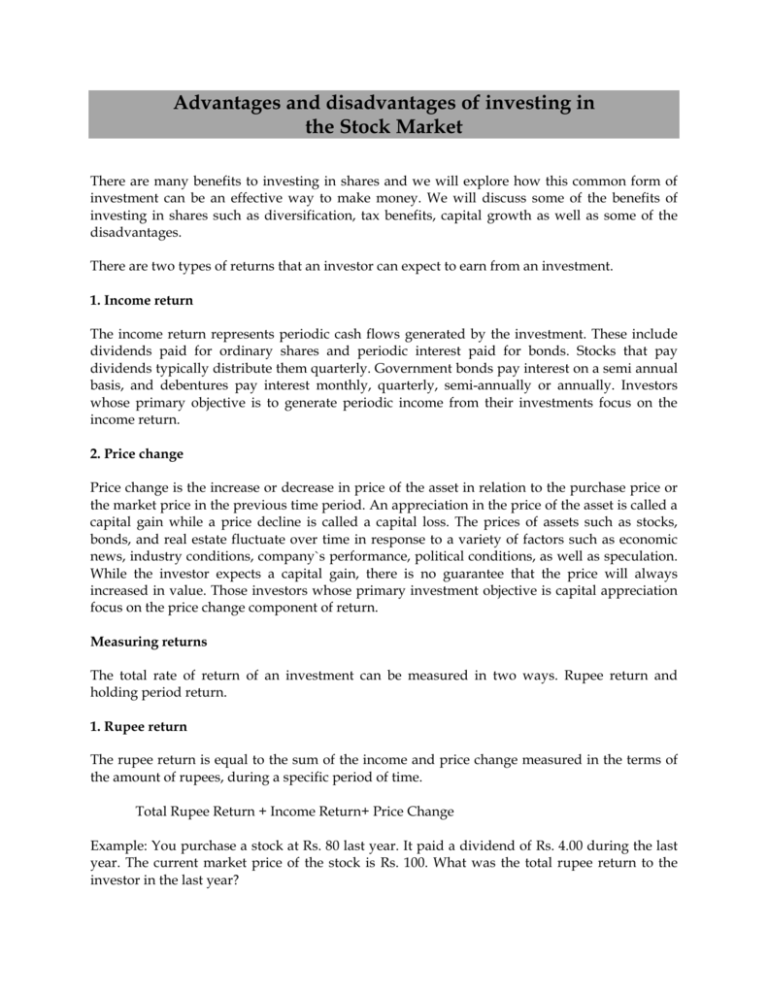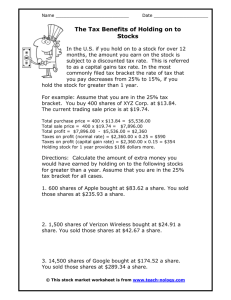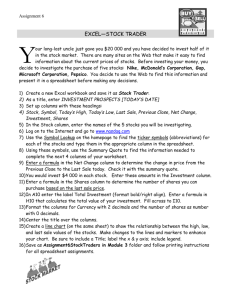Advantages and disadvantages of investing in the Stock
advertisement

Advantages and disadvantages of investing in the Stock Market There are many benefits to investing in shares and we will explore how this common form of investment can be an effective way to make money. We will discuss some of the benefits of investing in shares such as diversification, tax benefits, capital growth as well as some of the disadvantages. There are two types of returns that an investor can expect to earn from an investment. 1. Income return The income return represents periodic cash flows generated by the investment. These include dividends paid for ordinary shares and periodic interest paid for bonds. Stocks that pay dividends typically distribute them quarterly. Government bonds pay interest on a semi annual basis, and debentures pay interest monthly, quarterly, semi-annually or annually. Investors whose primary objective is to generate periodic income from their investments focus on the income return. 2. Price change Price change is the increase or decrease in price of the asset in relation to the purchase price or the market price in the previous time period. An appreciation in the price of the asset is called a capital gain while a price decline is called a capital loss. The prices of assets such as stocks, bonds, and real estate fluctuate over time in response to a variety of factors such as economic news, industry conditions, company`s performance, political conditions, as well as speculation. While the investor expects a capital gain, there is no guarantee that the price will always increased in value. Those investors whose primary investment objective is capital appreciation focus on the price change component of return. Measuring returns The total rate of return of an investment can be measured in two ways. Rupee return and holding period return. 1. Rupee return The rupee return is equal to the sum of the income and price change measured in the terms of the amount of rupees, during a specific period of time. Total Rupee Return + Income Return+ Price Change Example: You purchase a stock at Rs. 80 last year. It paid a dividend of Rs. 4.00 during the last year. The current market price of the stock is Rs. 100. What was the total rupee return to the investor in the last year? Income return is the Rs. 4.00 dividend. Price change is Rs. 20.00, which represents the increase in price from the purchase price of Rs. 80 the current price of Rs. 100. Total rupee Return + Rs. 4+ Rs. 20= Rs. 24 2. Holding period return Holding period return is a very basic way to measure how much return you have obtained on a particular investment (HPR)i.e the sum of the income and capital gains generated during a specific period as a percentage of the initial purchase price or the beginning of the period price of the investment. The holding period return is given by the following equation HPR = income + Price Change Purchase Price * 100 Example: you purchased a stock at Rs. 80 last year. It paid a dividend of Rs. 4.00 during the last year. The current market price of the stock is Rs. 100. What was the holding period return to the investor in the last year? HPR = 4 + 20 80 * 100 = 30% Example: you purchased a stock at Rs. 80 two years ago. It paid a dividend of Rs. 4.00 in the first year and Rs. 4.25 in the second year. The market price of the stock at the end of the first year was Rs. 100. The current market price is Rs. 120.75. What was the holding period return to the investor in the last year? HPR = 4.25 + 20.75 * 100 = 25% 100 3. Voting right Shareholders have a say in the affairs of the company. One of the ways they express themselves is by voting at the Annual and Extra-ordinary general meetings of the company .The board of directors needs the ratification of shareholders, before any major decision is taken. For instance, shareholders must give their consent before a company embarks on a public offer or a right issue. They also have the rights to sack erring directors. They do this by exercising their voting right. Shareholders do not necessarily need to be physically present at the site of the company's annual meeting in order to exercise their right to vote. It is common for shareholders to voice their vote by proxy by mailing in their response. 4. Right issues A rights issue is an invitation to existing shareholders to purchase additional new shares in the company. More specifically, this type of issue gives existing shareholders securities called "rights", which, well, give the shareholders the right to purchase new shares at a discount to the market price on a stated future date. Each share holder is given the option to purchase a number of shares in proportion to the number of shares already held by the share holder. For example, a right ratio of one-for-two means a share holder can subscribe to one new share for each two shares already held by the shareholder. An investor owing 100 shares prior to the right issue gets the right to subscribe to 50 new shares. This increases the firm`s number of shares outstanding. 5. Capitalization of reserves When reserves are paid out to shareholders in the form of extra shares is called capitalization of reserves. In other way, Capitalization of Reserves is the issue of shares by the company to its existing shareholders by capitalizing its revenue reserves. Share holders receive free shares in proportion to their ownership. For example, a free share issue of one-for-five means that each shareholder receives one free share for each five shares held. An investor who owns 100 shares before the free share issue receives 20 additional shares without cost. When the company issues free shares by doing capitalization of reserves the company`s stated capital and the total number of shares will be increased. 6. Stock splits Sometimes, companies split their shares into more shares. A stock split is where a company subdivides its outstanding shares so as to increase the number of shares. For example, one-fortwo will create one new share for each two shares outstanding. A company with 100,000 shares will create new shares, and as a result, the total number of shares outstanding increase to 150,000 shares. A share holder who owned 100 shares will now own 150 shares worth the same. The company does not receive any funds, and hence, there is no change in the value of the firm. The only change is that the company will transfer the value of the new shares from revenue reserves to share capital. However since the firm has more shares now, the price per share will decline to reflect this. 7. Liquidity Another benefit of investing in shares is that it is a liquid asset. The stocks traded in the market also have greater liquidity than other securities. This means that it can be easily converted into cash by selling the equities with other traders in the market because it is relatively easy to find buyers.Compare this to selling property, where you may have only 1 or 2 interested buyers. 8. Accessibility Another advantage of investing in stocks is its accessibility. There are many stocks available in the market today. With proper research and analysis of the stocks and the companies that issued them, anybody with sufficient capital can acquire ownership of stocks except some specific stocks. 9. Ease of diversification Diversification is simply not putting all your eggs in one basket. If you make smaller investment in various different companies, the likelihood that one of your investments fails means that it won’t have a great effect on your total investment. If you have all your eggs spread between a number of baskets (investments), you are more insulated from any possible downturns. Because you can buy small parcels of shares ($500 is the minimum per parcel), you can get greater diversification though investing in shares. Compare this to say property where a large sum of money is placed in just one investment 10. Tax benefits Many of the costs associated with share trading are tax deductible, as you have to pay tax on your gains. Transaction fees, interest paid on margin loans and other costs associated with your investments can be deducted as an expense from your taxable income from the shares you’ve traded. Tax benefits can also come from franking credits (imputation credits) from shares. As companies have already pay tax on their profits investors receive franking credits on the dividends they receive. 11. Availability of information Information about a particular companies shares, especially Milanka Companies shares, are just about everywhere, news on TV, newspaper and most financial websites. Some of the other advantages of investing in the stock market include: • • • Superior long term performance - over the long term, stocks have consistently provided better returns than any other type of investment. Stocks have consistently stayed ahead of the inflation rate, something that is not always true of bonds and other fixed income investments. For instance, if your money market is yielding 2% a year, but inflation is 3%, you are actually losing money. The returns of the stock market provide investors with a better chance of staying ahead of inflation. Owning stocks allows the investor to participate in the growth of the economy. When you buy shares of stock, you actually become part owner of the company, and you therefore are entitled to share in the good fortunes of that company. • Stocks can be an excellent choice for retirement vehicles, especially for those with a long time to retirement. The longer your time horizon, the more valuable stocks can be. A long time horizon will help to even out the inevitable ups and downs of the market. Disadvantages of investing in the stock market include: • • • • Stocks are volatile investments. The price of a single stock can vary quite widely from day to day, and the factors that cause these price fluctuations are beyond the control of the investor. Buying a widely diversified basket of stocks can be difficult for all but the wealthiest investor. Small investors are better off buying a quality stock mutual fund. Mutual funds pool the investments of many different people in order to buy a diversified set of stocks. This diversified approach helps to reduce the risk inherent in the stock market. As investors near retirement, the amount of stocks in the portfolio should be reduced. Investors who are close to retirement age can no longer afford to take chances with their money, and that means moving a significant portion of their retirement funds to safer and more stable investments. Buying and selling stocks costs money in the form of brokerage commissions, and many brokerage firms charge account maintenance fees as well. It is important to look for low cost alternatives when buying and selling stocks.








